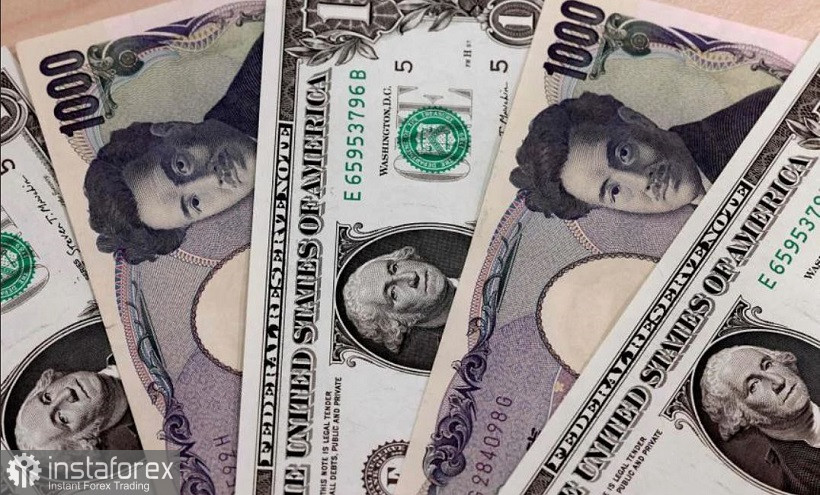The USD/JPY pair resumed its upward movement. Last week, the yen was trading in a 100-point price range against the dollar, not leaving the 126.50-127.50 range. However, yesterday the bulls became much more active due to the strengthening of the US currency. The pair left the aforementioned price level and is currently testing the resistance level of 128.80 (the middle line of the Bollinger Bands indicator, coinciding with the Kijun-sen line on the D1 timeframe).

USD/JPY traders were initially skeptical about the general weakening of the greenback, which was observed in the middle of this month. On May 9, bulls once again tested the 131st figure, but did not keep the peak taken. The price began to slowly but surely roll down. However, contrary to general trends, the bears failed to build on their success. Having reached the middle of the 126th figure, they stopped and, as they say, fell into a drift.
It is noteworthy that the yen ignores the Japanese macroeconomic statistics, even despite the fact that key economic indicators have been coming out in the green zone lately. A report on the labor market in Japan was published today. The unemployment rate fell to 2.5% - the indicator shows a downward trend for the second consecutive month. Also pleased with retail sales, the volume of which increased by 2.9% year on year (this is the highest growth rate of the indicator since June last year).
A fairly strong inflation report was published earlier (May 20): all components of the release exceeded the forecast values. The general consumer price index in Japan continued its upward movement, having risen to the level of 2.5% (against the forecast of growth up to 1.5%). This is the strongest growth rate since November 2014. The consumer price index, excluding fresh food prices, also showed positive dynamics, rising to 2.1% in April. The growth rate was the highest since March 2015. The consumer price index, excluding food and energy prices, left the negative area for the first time in many months, being at around 0.8%. Food prices in Japan jumped by 4% in April (this is the strongest price increase in the last seven years). The price of fuel and utilities has risen significantly (by 15.7% at once). Clothes and footwear increased in price by 0.8%, furniture went up by 2.3%.
The yen reflexively reacted to the growth of Japanese inflation, but then returned to the sphere of influence of the US currency. Now the USD/JPY pair is also gaining momentum solely due to the general strengthening of the dollar. Traders completely ignored the Japanese macroeconomic reports in the labor market and retail sales. This is due to the dovish position of the Bank of Japan, which at its last meeting reiterated its commitment to accommodation policy. In one of his speeches, BOJ Governor Haruhiko Kuroda said that the Japanese central bank would not follow the Federal Reserve in the context of raising rates. He said that "while central banks in the US, UK, Canada are moving towards tightening monetary policy or raising rates, the Japanese economy is still on track to recover from the impact of the coronavirus pandemic." Moreover, he expressed his willingness to ease monetary policy, stressing that he would "without hesitation" initiate appropriate steps "if necessary."
All this suggests that the USD/JPY pair will continue to follow the path of the US dollar index. The index was growing quite confidently on Tuesday, reflecting the increased demand for the US currency. Following it, the dollar-yen pair is also growing, gradually approaching the 129th figure.
The greenback strengthens its position amid the growth of the oil market due to increased inflationary expectations. There is growing confidence in the market that the Fed will be forced to implement more aggressive measures to tighten monetary policy. After the publication of the minutes of the Fed's May meeting, a number of currency strategists had doubts that after two 50-point increases, the central bank would continue to maintain such a "sporty" pace. However, if US inflation in the second half of the year again sets new multi-year records, the central bank will have to react accordingly. That is why the dollar is currently trying to dominate in all pairs of the "major" group. Paired with the yen, the greenback clearly indicated the priority of the upward movement.
Technically, the pair is currently trying to overcome the middle line of the Bollinger Bands indicator, which coincides with the Kijun-sen line on the D1 timeframe (resistance level 128.80). It is advisable to open long positions after overcoming this target and consolidating above 129.00. In this case, the Ichimoku indicator will form a bullish Parade of Lines signal. The main growth targets are 130.00 and 130.80 (the upper line of the Bollinger Bands on the same timeframe).





















